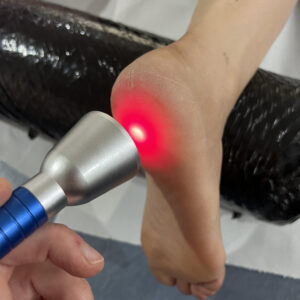Harness the Transformative Healing Benefits of High-Intensity Laser Therapy from Local Professionals
High-intensity laser therapy (HILT) is an innovative treatment approach that offers remarkable healing advantages by utilizing non-invasive laser techniques. This advanced therapy is specifically crafted to alleviate pain and expedite recovery by delivering a concentrated beam of light energy to targeted areas of the body. Unlike traditional laser treatments, HILT penetrates deeply into the tissues, promoting effective pain relief and facilitating quicker healing times. By focusing on the affected regions, patients can experience significant reductions in discomfort, paving the way for a more accelerated path to recovery and improved overall well-being.
While both HILT and Low-Level Laser Therapy (LLLT) leverage laser technology, their applications and effects differ markedly. LLLT is primarily used for superficial conditions like skin rejuvenation and minor wound healing. Conversely, HILT is adept at addressing deeper musculoskeletal problems, effectively managing chronic conditions such as chronic back pain, knee pain, and arthritis. This versatility makes HILT an excellent choice for a diverse range of patients seeking effective and lasting pain relief solutions.
Essential Insights About the Efficacy of High-Intensity Laser Therapy
- High-Intensity Laser Therapy offers a non-invasive pathway to pain relief and improved recovery outcomes.
- This state-of-the-art laser light therapy activates cellular processes, enhancing blood circulation in the treated areas for optimal recovery.
- The extensive benefits of laser pain therapy include reduced inflammation, increased mobility, and accelerated healing times.
- Individuals from various demographics, including athletes, seniors, and those managing chronic pain, can all reap the rewards of laser therapy.
- Conditions such as back pain, knee pain, arthritis, and sports injuries can be effectively treated using this advanced laser therapy technique.
 Explore the Mechanisms of Laser Light Therapy for Effective Healing
Explore the Mechanisms of Laser Light Therapy for Effective Healing
Laser light treatment is designed to activate the body's natural healing mechanisms on a cellular level. When cells absorb laser light, it triggers essential metabolic reactions that accelerate tissue recovery while simultaneously reducing inflammation.
The crucial interaction between laser light and mitochondria—the energy-producing organelles within cells—plays a significant role in the healing process. This interaction boosts ATP production, often referred to as the energy currency of cells. As ATP levels rise, cellular metabolism is enhanced, significantly aiding in the repair of damaged tissues, fostering a more rapid recovery.
Moreover, laser light therapy enhances blood circulation in the treated area, effectively delivering vital oxygen and nutrients to cells while promoting the elimination of waste products and toxins. Improved circulation is fundamental in reducing inflammation and swelling, which are essential for alleviating pain and fostering overall recovery.
Uncover the Comprehensive Benefits of Laser Pain Therapy for Enhanced Health
The benefits of laser therapy for pain management are extensive and multifaceted. One of the most prominent advantages is its ability to minimize inflammation, which is a common response to injury or illness and can lead to chronic pain and tissue damage if not effectively managed.
Laser therapy effectively combats inflammation by promoting blood flow and stimulating the production of anti-inflammatory compounds, which are essential for healing. Another noteworthy benefit of this therapy is its ability to accelerate the healing process. By enhancing cellular metabolism and ATP production, laser therapy facilitates the regeneration of injured tissues, making it particularly advantageous for individuals suffering from chronic conditions such as arthritis or tendonitis.
In addition to promoting healing, laser therapy is adept at alleviating pain by blocking pain signals and encouraging the release of endorphins—natural pain-relieving substances produced by the body. This can significantly reduce the reliance on pharmaceutical interventions, thereby enhancing overall quality of life and well-being.
Identifying Who Can Benefit from Laser Therapy: A Comprehensive Guide
Laser therapy is appropriate for a diverse range of patient populations, encompassing athletes recovering from sports-related injuries and seniors grappling with persistent chronic pain. This adaptable treatment can be utilized independently or in conjunction with other therapeutic modalities such as chiropractic care or physical therapy, delivering optimal results.
Conditions affecting muscles and joints, including arthritis, chronic back pain, knee pain, and neck pain, are particularly suitable for laser treatment. Furthermore, it proves effective for soft tissue injuries—including tendinitis, sprains, and strains—making it a holistic approach to managing various ailments effectively.
Laser therapy is also a safe and effective alternative for patients across all age groups, including children and older adults. As a non-invasive and drug-free method for managing pain, it emerges as an attractive choice for individuals seeking natural and holistic health solutions.
An In-Depth Overview of Conditions That Laser Therapy Can Treat Effectively
Laser therapy serves as a versatile treatment option that effectively addresses both acute and chronic medical conditions. Some specific issues that can be successfully treated using laser therapy include:
- For those experiencing persistent back pain, laser therapy can substantially reduce inflammation and facilitate the healing of affected muscles and tissues.
- Knee pain: Laser therapy is effective for treating osteoarthritis, tendinitis, and ligament injuries that contribute to knee discomfort.
- Laser therapy can effectively alleviate inflammation and pain associated with arthritis, thereby enhancing joint function and mobility.
- For athletes, laser therapy promotes quicker recovery from common sports injuries, including sprains, strains, and tendinitis.
- Chronic neck pain stemming from herniated discs and muscle strains can also benefit significantly from laser therapy.
- In cases of plantar fasciitis, laser treatment can relieve heel pain by minimizing inflammation and promoting the healing of the plantar fascia.
- Laser therapy can assist in reducing inflammation and pain associated with carpal tunnel syndrome, thus improving hand function and potentially decreasing the need for surgical interventions.
Understanding How Laser Therapy Provides Relief for Back Pain: Essential Insights
Back pain is a prevalent condition that can significantly interfere with daily life, making it a debilitating issue for countless individuals. Fortunately, laser therapy presents a promising solution for those suffering from back pain, offering comfort and facilitating faster healing.
If you are currently enduring back pain, attending a laser therapy session may be the ideal step toward finding relief. The laser light penetrates deeply into tissues, stimulating cellular metabolism and ATP production, which assists in diminishing inflammation and promoting tissue repair.
The benefits of laser therapy for back pain include reduced inflammation and discomfort, enhanced mobility, and accelerated recovery times. This therapeutic option is not only safe and effective but also provides a non-invasive alternative to medication and surgical options, making it suitable for individuals dealing with various types of back pain.
 Knee Pain Relief Through Laser Therapy: What You Can Anticipate from Treatments
Knee Pain Relief Through Laser Therapy: What You Can Anticipate from Treatments
Knee pain may result from various conditions, including ligament injuries, tendinitis, or arthritis. Laser therapy offers a viable option for alleviating swelling and expediting the healing process in the injured tissues, effectively relieving knee discomfort.
During a laser therapy session focused on knee pain, the practitioner directs the laser beam specifically at the knee joint. The laser light penetrates deeply into the tissues, promoting cellular metabolism and ATP production, which assists in reducing inflammation and fostering tissue repair.
Patients typically experience a pleasant warmth during the treatment, which should not cause discomfort. Standard treatment sessions last between five and fifteen minutes, although this duration may vary based on the individual’s condition and specific needs.
To achieve optimal results, multiple sessions may be required, with most patients needing between six and twelve treatments. The frequency and number of sessions depend on the severity of the condition and the patient’s response to therapy.
Analyzing the Safety and Effectiveness of High-Intensity Laser Therapy
High-intensity laser therapy is widely regarded as a safe and effective treatment option for healing damaged tissues and alleviating pain. For patients seeking a more natural and holistic method of pain management, this non-invasive therapy represents an excellent choice, as it does not involve medications or surgical procedures.
Like any medical intervention, HILT may carry potential risks and side effects. Common but minor side effects might include localized redness or swelling at the treatment site, mild discomfort during or after the procedure, and a temporary exacerbation of symptoms.
It is essential to consult with a healthcare provider prior to commencing treatment to determine whether HILT is appropriate for your specific condition. A qualified practitioner can provide personalized recommendations tailored to your health status and medical history.
 Your Comprehensive Guide to Locating Local High-Intensity Laser Therapy Providers
Your Comprehensive Guide to Locating Local High-Intensity Laser Therapy Providers
Selecting a reputable laser therapy provider in your area is crucial if you’re considering high-intensity laser therapy for pain management or injury rehabilitation. Here are some effective strategies to help you identify a qualified practitioner:
- Start by conducting online searches for local providers. Look for practitioners with strong reputations who specialize in high-intensity laser therapy.
- Seek recommendations from others. Consult friends, family, or healthcare professionals who have had positive experiences with high-intensity laser therapy, as they may know someone trustworthy.
- Assess credentials: Ensure your chosen practitioner holds the necessary licenses and certifications. They should possess the training and expertise required to provide safe and effective treatment.
- Schedule a consultation with your healthcare provider to discuss your symptoms, diagnosis, and treatment options before committing to any therapy. This is a valuable opportunity to ask questions and determine if the available options align with your specific needs.
What to Anticipate During Your Laser Therapy Experience: A Step-by-Step Overview
During a laser therapy session, you can expect to be comfortably seated or lying down while the practitioner skillfully directs the laser beam to the injury site, treating each area with precision and care.
Although you may feel warmth during the treatment, it should not cause any pain. If you do experience discomfort, it is essential to communicate this to your provider so they can adjust your treatment as needed.
The duration of the treatment will vary depending on the size of the area being treated and the severity of the condition, typically lasting between five and fifteen minutes. Multiple sessions may be required to achieve the best results, with most patients needing between six and twelve sessions.
After treatment, your clinician may recommend avoiding strenuous activities or applying ice to the treated area to ensure optimal recovery. Following these guidelines is crucial for maximizing the effectiveness of your therapy.
This discussion highlights the numerous advantages of laser therapy for effective pain management. If you are on the lookout for a local provider of high-intensity laser therapy, consider the various conditions such as arthritis, sports injuries, and chronic pain that this innovative treatment can help alleviate. In addition to clarifying the underlying science, it elaborates on the benefits of this non-invasive therapy option. To find a clinic near you and learn more about high-intensity laser therapy, click here: High-Intensity Laser Therapy: A Powerful Solution for Pain Management.
Your Queries Addressed: Common Questions About High-Intensity Laser Therapy
What is high-intensity laser treatment?
High-intensity laser therapy is a non-invasive medical treatment that utilizes a high-powered laser to stimulate healing and alleviate pain within damaged tissues. It serves as a modern solution for those experiencing discomfort and seeking effective relief.
How does high-intensity laser therapy function?
High-intensity laser therapy employs a focused beam of light energy directed at the affected area. This energy penetrates deeply into the tissues, promoting cellular activity and facilitating the body's natural healing processes, ultimately leading to pain relief and improved function.
What conditions can high-intensity laser therapy effectively treat?
High-intensity laser therapy is versatile and can effectively treat a wide range of conditions, including chronic pain, arthritis, sports injuries, and post-surgical pain, making it a comprehensive option for pain management and rehabilitation.
Is high-intensity laser therapy safe?
Yes, high-intensity laser therapy is generally considered safe. However, it is essential to ensure that treatment is administered by a qualified healthcare professional experienced in this specific therapeutic approach to ensure optimal outcomes.
What advantages does high-intensity laser therapy offer?
The benefits of high-intensity laser therapy include reduced pain and inflammation, enhanced circulation, and accelerated healing, providing patients with a holistic approach to pain management and overall wellness.
How long does a typical high-intensity laser treatment session last?
The duration of a high-intensity laser therapy session can vary based on the condition being treated and the severity of symptoms, but it usually lasts between 10 to 30 minutes, allowing for effective treatment without prolonged discomfort.
How many sessions of high-intensity laser treatment are typically required?
The number of high-intensity laser therapy sessions needed varies among patients based on their individual conditions. While some may notice improvements after just one session, others may require multiple treatments over several weeks or months to achieve optimal results and complete recovery.
The Article High-Intensity Laser Therapy: Find Local Experts Today appeared first on https://mcrtherapies.com
The Article High-Intensity Laser Therapy: Locate Local Specialists Now Was Found On https://limitsofstrategy.com


It’s fascinating how technology like high-intensity laser therapy is changing the landscape of pain management and recovery. I’ve been reading about its potential not just for athletes but also for those of us dealing with chronic pain or injuries from everyday mishaps. It’s like we’re finally merging traditional healing practices with modern tech in a way that can actually improve quality of life. I wonder how accessible these treatments are for people who might not have local providers. Also, are there specific conditions where you’ve found HILT to be most effective? It’d be interesting to see some case studies or testimonials from patients who’ve experienced real changes.
You brought up some really interesting points about high-intensity laser therapy (HILT) and its expanding role in both sports medicine and everyday pain management. It is indeed a compelling blend of traditional healing and modern technology, and it’s exciting to think about how it can improve quality of life for so many people.
It’s great to hear that you found the points about high-intensity laser therapy (HILT) interesting. The intersection of traditional healing practices and modern technology is really fascinating, especially as we look for effective ways to manage pain and enhance performance.
I recently came across an article that dives deeper into how high-intensity laser therapy can be a game changer for back pain relief, and I thought you might find it just as intriguing.
‘High Intensity Laser Therapy: Effective Relief for Back Pain’
https://soonrs.com/high-intensity-laser-therapy-effective-relief-for-back-pain/.
It’s nice to connect over our shared interest in high-intensity laser therapy—there’s so much to unpack in that area! The blend of traditional healing practices with modern technology is not just intriguing, but it really reflects how we’re evolving our approach to health and wellness. Pain management, especially for something as persistent as back pain, can be a game changer for many people.
I completely agree with your perspective on the blend of traditional healing practices and modern technology. It’s fascinating how high-intensity laser therapy has emerged as a viable treatment option, bridging those two worlds. I’ve read quite a bit about how It can stimulate cellular repair and reduce inflammation, which seems especially beneficial for chronic pain, like back pain.
It’s interesting to think about how traditional healing practices can mesh with modern technologies like high-intensity laser therapy. The way it stimulates cellular repair and reduces inflammation really opens up new possibilities for treating chronic conditions. I’ve seen firsthand how people who struggle with issues like back pain often feel resigned to live with discomfort, so having innovative options can feel like a lifeline.
It’s really interesting to see how innovative therapies like high-intensity laser therapy (HILT) are gaining attention in the pain management landscape. I appreciate how you’ve highlighted the blend of traditional practices and modern technology; that intersection often leads to some of the most effective treatments.
I recently read an insightful piece on cupping therapy that explores its benefits and secrets, and I think you’ll find its blend of traditional and modern approaches to healing quite compelling too.
‘Cupping Therapy Benefits and Secrets Revealed’
https://soonrs.com/cupping-therapy-benefits-and-secrets-revealed/.
You’re hitting on something really important with the blend of traditional healing and modern technology. High-intensity laser therapy (HILT) is such a fascinating area because it shifts the dynamics of how we approach pain and injury recovery. Athletes pushing their limits are one thing, but the potential for everyday folks dealing with chronic pain is equally transformative.
It’s great to hear your thoughts on high-intensity laser therapy (HILT) and its transformative role in pain management. You’re right; it’s truly exciting to see how technology can align with traditional healing practices to enhance our well-being.
You’ve brought up some vital points about high-intensity laser therapy (HILT) and its growing role in pain management. The merging of traditional healing and modern technology is certainly exciting, especially as more people encounter chronic pain or injuries in their daily lives.
You’ve captured an important aspect of the conversation around high-intensity laser therapy (HILT) and its potential to bridge the gap between traditional healing and modern approaches. It’s a landscape that’s evolving, especially as more individuals confront the realities of chronic pain and varying injuries in their routines.
I find it fascinating how technology like high-intensity laser therapy (HILT) is reshaping our approach to healing and pain management. I remember struggling with chronic pain a few years ago and trying various treatments, from physical therapy to acupuncture. It’s refreshing to see innovations like HILT gaining attention because it really feels like we’re entering a new era in healthcare where traditional pain relief methods are being complemented by advanced technologies.
It’s intriguing to see how technologies like HILT are carving out new pathways in pain management and healing. Your experience with chronic pain really resonates with me; I think many people struggle with finding effective solutions, and the journey can be exhausting.
It’s great to hear that you connect with what I shared. The struggle with chronic pain really can feel isolating and overwhelming at times. Technologies like HILT offer some hope, but it’s also about finding the right approach for each individual.
I find the discussion around high-intensity laser therapy (HILT) quite fascinating, especially as we see it emerging as a game-changer in pain management and recovery. Having dealt with chronic back pain for several years, I’ve explored various treatments, which makes the promise of HILT particularly appealing. The ability to penetrate deeper into tissues sounds like a significant step up from traditional methods.
I appreciate the perspective you’ve shared about high-intensity laser therapy (HILT). Chronic pain can often feel like a relentless battle, and finding effective management strategies is so crucial. It sounds like you’ve really explored a variety of treatments over the years, which gives you a valuable understanding of what works and what doesn’t.
It’s fascinating to see how high-intensity laser therapy is evolving as a powerful option for pain relief and recovery. I’ve heard from friends who’ve undergone it for chronic injuries, and they often mention not just reduced pain, but an enhanced quality of life with quicker daily function returns. It sparks a thought about the broader implications of integrating such advanced therapies into mainstream healthcare—how could we see a shift in pain management strategies as more practitioners adopt these technologies? Plus, with the rise of integrative health approaches, HILT could really complement other modalities like physical therapy and chiropractic care. Have others here explored HILT treatments, or do you think it’s something we’ll see more widely embraced in the near future?
You’ve raised some really thoughtful points about high-intensity laser therapy (HILT) and its potential to reshape pain management approaches. It’s interesting to see how those who’ve experienced it firsthand often mention not just the reduction in pain, but also that boost in their daily lives. When people can return to their regular activities and enjoy a higher quality of life, it really highlights the importance of exploring and integrating new treatment options into mainstream healthcare.
You’re raising some really important points about high-intensity laser therapy (HILT) and its potential role in pain management and recovery. It’s encouraging to hear firsthand accounts of how people are experiencing not just pain relief but a real enhancement in their quality of life. This aligns with what many practitioners have noted: that HILT isn’t just a treatment for the symptoms but can actually support a person’s overall well-being.